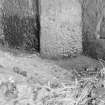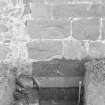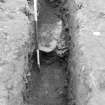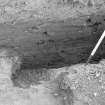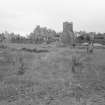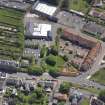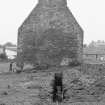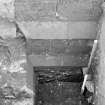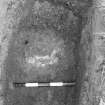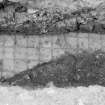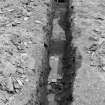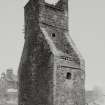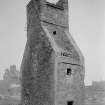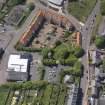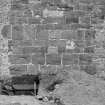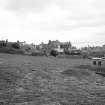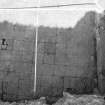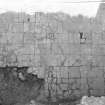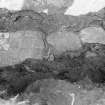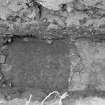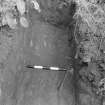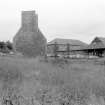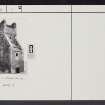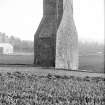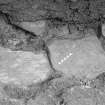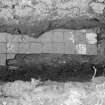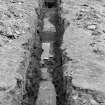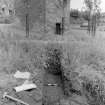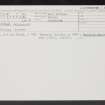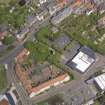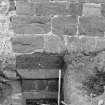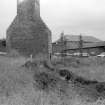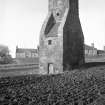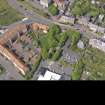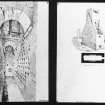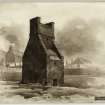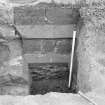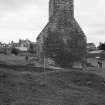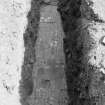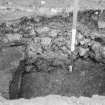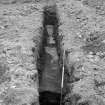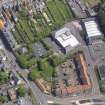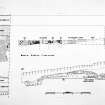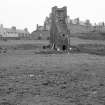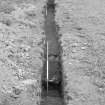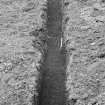Dunbar, Friarscroft
Dovecot (Post Medieval), Priory (Medieval)
Site Name Dunbar, Friarscroft
Classification Dovecot (Post Medieval), Priory (Medieval)
Alternative Name(s) Friar's Croft; Red Friars Dovecot
Canmore ID 57675
Site Number NT67NE 7
NGR NT 67788 78839
Datum OSGB36 - NGR
Permalink http://canmore.org.uk/site/57675
- Council East Lothian
- Parish Dunbar
- Former Region Lothian
- Former District East Lothian
- Former County East Lothian
NT67NE 7.00 67790 78840
NT67NE 7.01 c. 678 788 Almshouse
(NT 6779 7884) Rems of (NAT) Monastery (NR) (Trinitarian) (NAT)
OS 6" map (1971)
This dovecot was in a very good condition when seen in 1962.
Visited by OS (DT) 28 August 1962.
The small house of Trinitarian or Red Friars at Dunbar is stated to have been 'biggit and foundit' by Cristiana de Brus, countess of Dunbar, this foundation probably taking place in 1240-8. The priory was dissolved in 1529 (I B Cowan and D E Easson 1976).
All that now remains is the tower for the church, which has been converted into a dovecot. It measures 27 by 12ft with random rubble walls and a single string course. In the interior there are about 200 nests cut at random in the walls. It is in good repair.
RCAHMS 1924, visited 1915; J Whitaker 1948; D C Bailey and M C Tindall 1963
The date '1716' is present on the W jamb of the entrance to the dovecot.
A N Robertson MS
A three week excavation confirmed that this dovecot was a central tower for the presumed friary church. The walls, though elsewhere robbed out, showed it to be a building 39m long by 8m wide. The chancel and nave were of an equal size, 16m long. Traces of a yellow and green glazed tile floor were found in the chancel, possibly dating to the foundation of the friary. Buttressing was found on the N side of the building. There was no trace of ancilliary claustral buildings. A cemetery was found to the S of the church. To the N of the church there was evidence of medieval ploughing.
Sponsor : SDD-HBM
J Wordsworth 1981
The field of Friarscroft, Dunbar, was examined in advance of redevelopment so that an assessment of its archaeological potential could be made. By tradition this field has been ascribed to the Red (or Trinitarian) Friars who founded a house at Dunbar c 1240 (Cowan and easson 1976, 108). This tradition was accepted by the RCAMS (1924, 29) when they examined a dovecot tower that still stands in the centre of the field. The ashlar masonry incorporated in this building, two substantial arches inside and two gable ends facaing respectively E and W, were interpreted as forming part of the Trinitarian Friars' Church. As a result of exploratory trenches the extent of this friary church and part of a cemetery were uncovered. No cloister or other associated buildings were found, though only a portion of the field could be counted.
J Wordsworth 1983
Trial excavations in advance of a proposed housing development took place in July 1987. Trenches were cut in the open field adjacent to the standing tower of the Church of the Trinitarian Friary. Part of the friary graveyard was located and a possible western limit to it was defined.
D W Hall 1987
Field Visit (27 August 1915)
In a field named the "Friar's Croft" to the south of a street still known locally as the "Friars' Vennel" at the western end of the burgh. through which passes the old road from Edinburgh to Berwick, is a dovecot of unusual form (fig. 22), which is obviously the only remnant of the Red or Trinity Friars at Dunbar, being the tower, found in many churches of friars between the choir and nave (fig. 64). So much is suggested by the roof raggles. It is further clear that the tusking of the side walls has been cleared off and the corners spliced. Close examination shows that arched openings in the east and west sides have been built up, and that there was an earlier entrance on the south side, rising above the present door. This would have served for access to the cloister. The nests for pigeons have been inserted. On plan the structure is oblong with its major axis approximately north and south and measures exteriorly 27 feet 3inches by 12 feet. The east and west walls are skewed to receive the high pitched roofs of the once adjoining buildings and terminate some 30 feet above ground level in a tower oblong on plan, borne interiorly on heavy semi-circular arches with moulded imposts.
This house of friars was suppressed apparently prior to the Reformation; a charter of 1558 granted to James Hume in Dunbar 3 ½ acres called ‘lie Freir-croft’. (R.M.S. (1580) No. 3037) (No. 42)
RCAHMS 1924, visited 27 August 1915.
[Registrum Magni Sigilli Regum Scotorum]
Photographic Survey (September 1960 - 1962)
Photographic survey of dovecots in East Lothian by the Scottish National Buildings Record in 1960-1962.
Excavation (1981)
A three week excavation confirmed that this dovecot was a central tower for the presumed friary church. The walls, though elsewhere robbed out, showed it to be a building 39m long by 8m wide. The chancel and nave were of an equal size, 16m long. Traces of a yellow and green glazed tile floor were found in the chancel, possibly dating to the foundation of the friary. Buttressing was found on the N side of the building. There was no trace of ancilliary claustral buildings. A cemetery was found to the S of the church. To the N of the church there was evidence of medieval ploughing.
Sponsor : SDD-HBM
J Wordsworth 1981
Publication Account (1981)
The first mention of a church at Dunbar occurs in the 1176 Taxatio of Lothian (Miller, 1830, 183). The church itself was dedicated apparently to one St. Bey (also known as St. Ann) an obscure, pious female who lived in strict seclusion on the small island of Cumbrae in the Firth of Clyde (Fish, 1929-30, 30). The original building was probably Norman with a western tower. A choir and presbytery were added in the thirteenth century. By the end of the eighteenth century the fabric of the church was described as being 'very old' and was 'till lately' in the inside 'especially of the worst and most inconvenient perhaps in Scotland' (Withringt0n, 1975, ii, 473). A new church was erected on the site of the old one in 1819.
Information from ‘Historic Dunbar: The Archaeological Implications of Development’ (1981).


































































